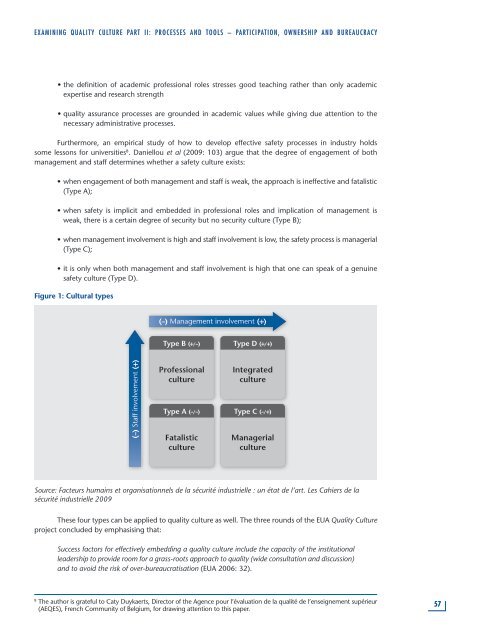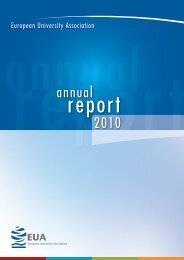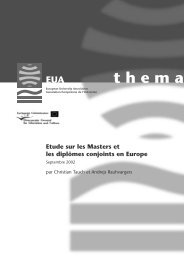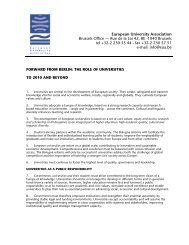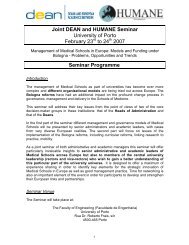Examining Quality Culture Part II: - European University Association
Examining Quality Culture Part II: - European University Association
Examining Quality Culture Part II: - European University Association
Create successful ePaper yourself
Turn your PDF publications into a flip-book with our unique Google optimized e-Paper software.
ExAmININg QUALITy CULTUrE PArT <strong>II</strong>: PrOCESSES ANd TOOLS – PArTICIPATION, OwNErShIP ANd BUrEAUCrACy<br />
• the definition of academic professional roles stresses good teaching rather than only academic<br />
expertise and research strength<br />
• quality assurance processes are grounded in academic values while giving due attention to the<br />
necessary administrative processes.<br />
Furthermore, an empirical study of how to develop effective safety processes in industry holds<br />
some lessons for universities 8 . Daniellou et al (2009: 103) argue that the degree of engagement of both<br />
management and staff determines whether a safety culture exists:<br />
• when engagement of both management and staff is weak, the approach is ineffective and fatalistic<br />
(Type A);<br />
• when safety is implicit and embedded in professional roles and implication of management is<br />
weak, there is a certain degree of security but no security culture (Type B);<br />
• when management involvement is high and staff involvement is low, the safety process is managerial<br />
(Type C);<br />
• it is only when both management and staff involvement is high that one can speak of a genuine<br />
safety culture (Type D).<br />
Figure 1: Cultural types<br />
(-) Staff involvement (+)<br />
(-) Management involvement (+)<br />
Type B (+/-)<br />
Professional<br />
culture<br />
Type A (-/-)<br />
Fatalistic<br />
culture<br />
Type D (+/+)<br />
Integrated<br />
culture<br />
Type C (-/+)<br />
Managerial<br />
culture<br />
Source: Facteurs humains et organisationnels de la sécurité industrielle : un état de l’art. Les Cahiers de la<br />
sécurité industrielle 2009<br />
These four types can be applied to quality culture as well. The three rounds of the EUA <strong>Quality</strong> <strong>Culture</strong><br />
project concluded by emphasising that:<br />
Success factors for effectively embedding a quality culture include the capacity of the institutional<br />
leadership to provide room for a grass-roots approach to quality (wide consultation and discussion)<br />
and to avoid the risk of over-bureaucratisation (EUA 2006: 32).<br />
8 The author is grateful to Caty Duykaerts, Director of the Agence pour l’évaluation de la qualité de l’enseignement supérieur<br />
(AEQES), French Community of Belgium, for drawing attention to this paper.<br />
57


